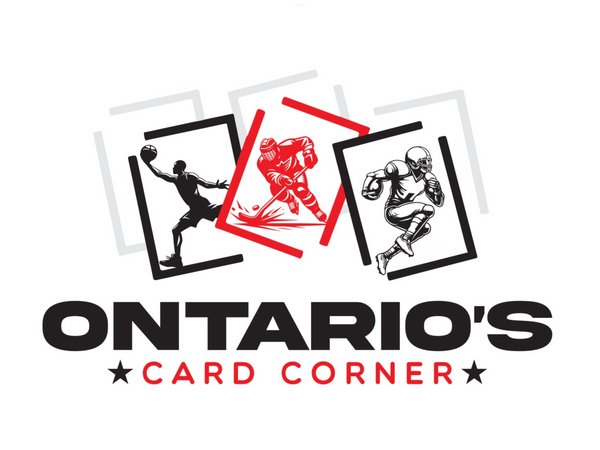Investing 101 in the Hobby: A Beginner’s Guide to Smart Sports Card Investments
Share
Hello, collectors! Coleman Bennett here, owner of Ontario’s Card Corner. Sports card collecting is more than just a hobby—it’s also an exciting avenue for investment. Over the years, I’ve seen collectors turn their passion for cards into portfolios that grow in value. If you’ve ever thought about investing in sports cards but weren’t sure where to start, this guide is for you.
Today, we’ll break down the basics of investing in sports cards, with a focus on hockey—a sport with some of the most iconic and collectible cards in the hobby.
1. Why Invest in Sports Cards?
Sports cards offer a unique blend of emotional and financial value. They allow you to celebrate your favorite players while also building an asset that could appreciate over time. Here are some reasons why sports card investing has grown in popularity:
-
Tangible Assets: Unlike stocks or cryptocurrencies, sports cards are physical items you can hold and display.
-
Diverse Market: From rookies to vintage legends, there’s a wide range of cards to fit any budget or interest.
-
Growth Potential: A player’s breakout season or Hall of Fame induction can cause card values to skyrocket.
2. Key Categories for Hockey Card Investments
Hockey cards offer a wealth of investment opportunities, from vintage classics to modern autographs. Here are some of the most promising categories:
A. Vintage High-Grade Cards
-
Why They’re Valuable: Vintage cards of hockey legends like Wayne Gretzky, Bobby Orr, and Gordie Howe are iconic and highly sought after. Their rarity and historical significance make them blue-chip investments.
-
What to Look For:
-
Graded cards with high grades (PSA 8 or above).
-
Key rookie cards, such as Gretzky’s 1979 O-Pee-Chee rookie card.
-
Cards of other legends like Maurice "Rocket" Richard, Jean Beliveau, Jacques Plante, and Stan Mikita.
-
B. Future Watch Autos and Patches
-
Why They’re Valuable: Upper Deck’s SP Authentic Future Watch cards are some of the most popular rookie cards in the hockey world. The combination of autographs, low serial numbers, and iconic designs make them excellent investments.
-
What to Look For:
-
Future Watch Autographs with low serial numbers (typically /999).
-
Cards from promising young players like Connor Bedard, Trevor Zegras, and Lucas Raymond.
-
Established stars such as Connor McDavid, Auston Matthews, and Nathan MacKinnon.
-
Future Watch Patch Autographs for added rarity and visual appeal.
-
C. The Cup RPA’s
-
Why They’re Valuable: Upper Deck’s The Cup Rookie Patch Autographs (RPAs) are the pinnacle of high-end hockey cards. Known for their premium patches and on-card autographs, these cards are grail items for many collectors.
-
What to Look For:
-
RPAs with multi-color patches.
-
Low serial numbers, often /99 or /249.
-
Rookie RPAs of elite players like Sidney Crosby, Alexander Ovechkin, Leon Draisaitl, and Cale Makar.
-
Newer stars like Jack Hughes, Kirill Kaprizov, and Tim Stützle.
-
D. Young Guns
-
Why They’re Valuable: Young Guns are iconic rookie cards that are highly collectible and widely recognized. They’re more accessible than RPAs, making them a great entry point for investors.
-
What to Look For:
-
Highly graded Young Guns cards (PSA 10 or BGS 9.5).
-
Star players like Connor McDavid, Auston Matthews, and Sidney Crosby.
-
Rising talents such as Trevor Zegras, Owen Power, Matty Beniers, and Cole Caufield.
-
Rare parallels, such as Young Guns Exclusives (/100) or High Gloss (/10).
-
E. Limited Edition Parallels and Inserts
-
Why They’re Valuable: Short-print parallels and inserts, like O-Pee-Chee Platinum parallels or Clear Cut inserts, add rarity and uniqueness to a collection.
-
What to Look For:
-
Cards with low print runs.
-
Popular designs or refractor finishes.
-
Inserts featuring greats like Mario Lemieux, Patrick Roy, Martin Brodeur, and current stars like Kirill Kaprizov and Jack Hughes.
-
3. Tips for Smart Card Investing
A. Research the Market
Before making a purchase, research recent sales on platforms like eBay or card marketplaces to understand a card’s current value. Stay updated on trends and emerging players.
B. Focus on Quality
Condition matters. High-grade cards command a premium, so prioritize cards with strong grades from reputable grading companies like PSA, BGS, or SGC.
C. Diversify Your Portfolio
Don’t put all your eggs in one basket. Invest in a mix of established stars, promising rookies, and vintage legends to balance your risk.
D. Buy Low, Sell High
Timing is everything. Consider buying during the off-season or when a player’s hype is low, and selling when demand spikes, such as after a major milestone or playoff performance.
E. Protect Your Investments
Use sleeves, top loaders, or graded cases to protect your cards from damage. Proper storage ensures your cards maintain their value over time.
4. Where to Buy and Sell
A. Trusted Sources
-
Reputable card shops like Ontario’s Card Corner.
-
Online marketplaces like eBay, COMC, or MySlabs.
B. Card Shows
Attending shows allows you to see cards in person, negotiate prices, and network with fellow collectors.
C. Grading Companies
Graded cards are verified for authenticity and condition, making them safer investments. PSA, BGS, and SGC are industry leaders.
Final Thoughts
Investing in sports cards is as much about passion as it is about profits. Whether you’re eyeing vintage grails, modern autographs, or iconic rookies, the key is to invest wisely and enjoy the journey. At Ontario’s Card Corner, we’re here to help you navigate the world of card investing with confidence.
If you’re ready to start or grow your investment collection, reach out to us or visit us at the next card show. Let’s build your portfolio together!
Happy collecting,
Coleman Bennett
Owner, Ontario’s Card Corner
